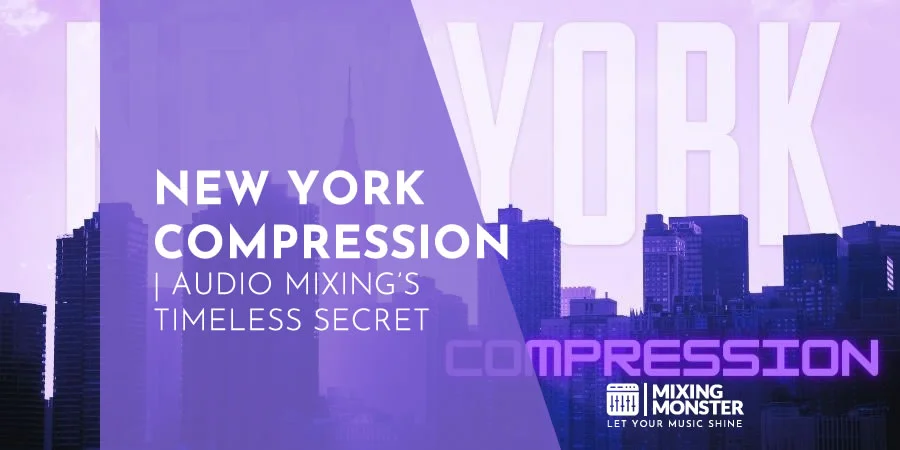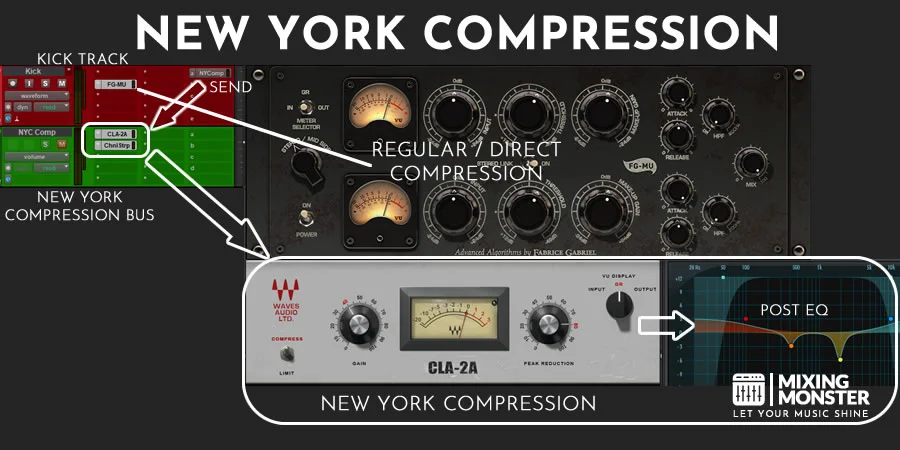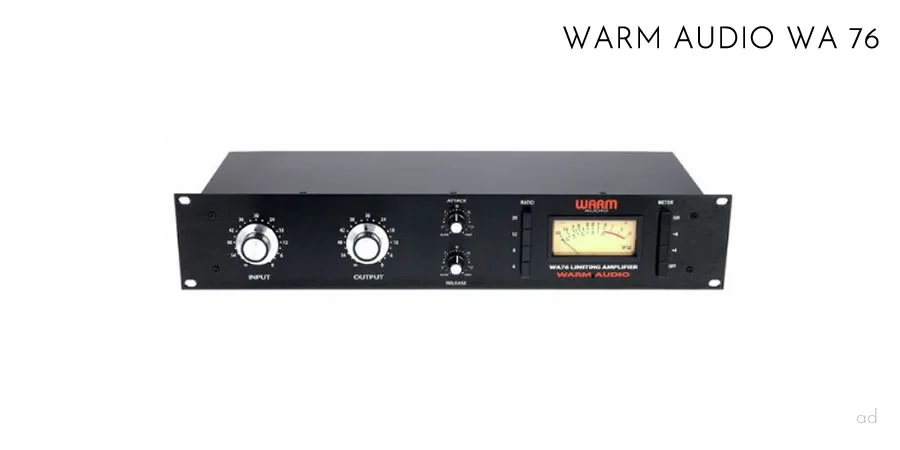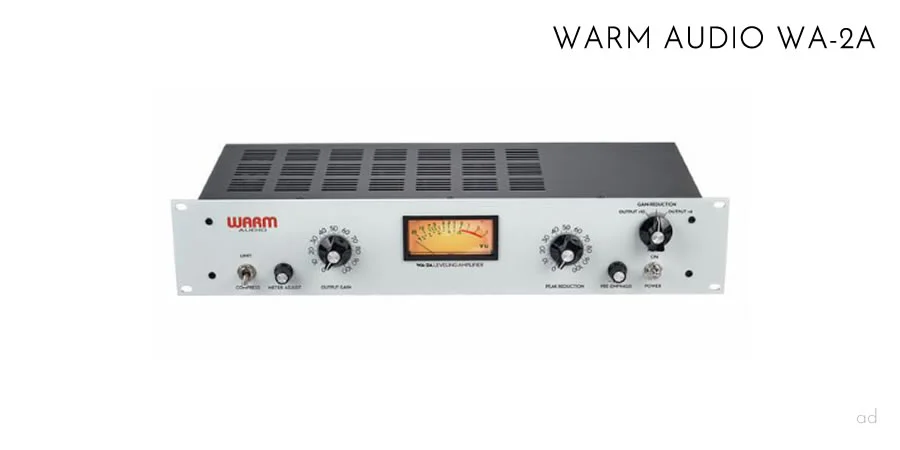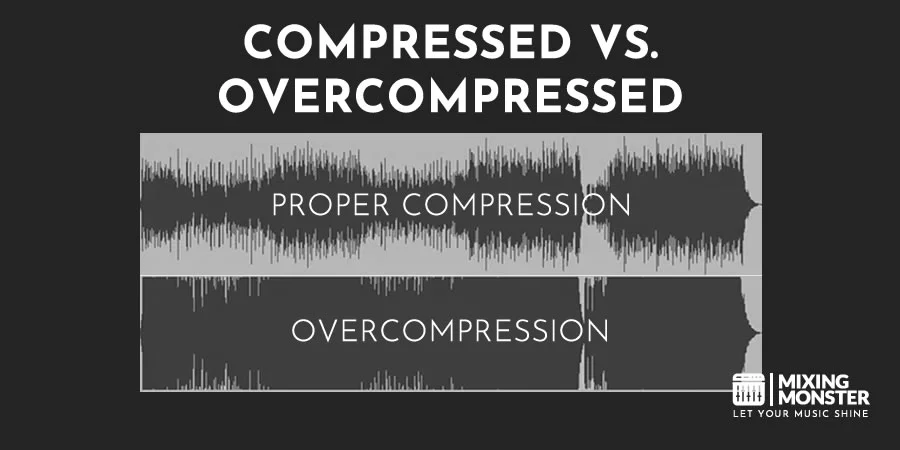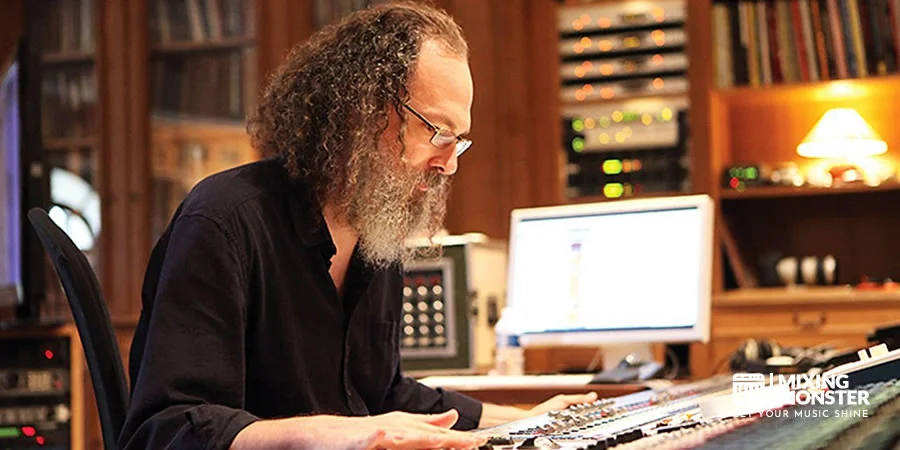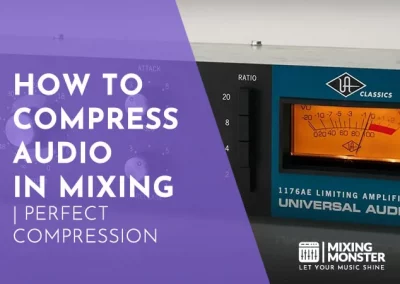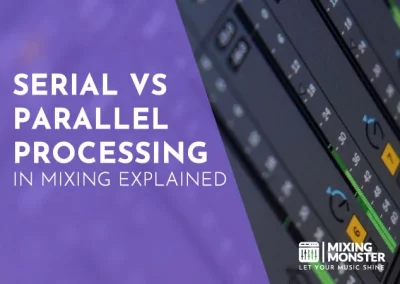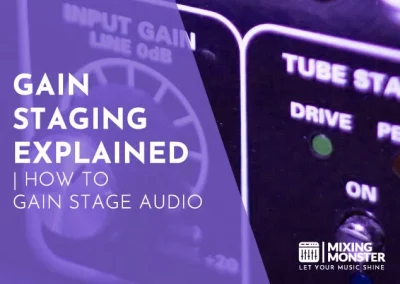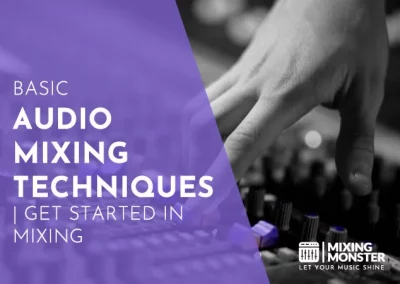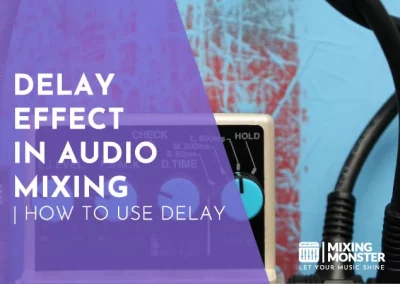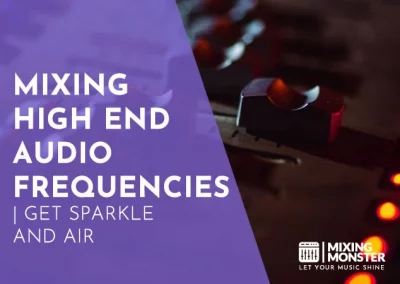Home > Blog > Mixing > Mixing Techniques
Affiliate Disclaimer: We may earn a commission if you purchase through our links
The New York compression technique has long been a secret weapon for audio engineers and producers seeking to add warmth, depth, and energy to their mixes. This powerful parallel processing method can enhance drums, vocals, and other instruments, creating a polished and professional sound that captivates listeners.
New York compression is a parallel processing technique in audio mixing which originated in New York City’s music production scene. It involves blending a heavily compressed version of a track with the original, unprocessed version. This method enhances dynamic range, adds warmth and depth, and increases perceived loudness without sacrificing musicality.
Discover the magic of New York compression, the secret audio mixing technique that can transform your tracks into dynamic, professional productions. Unleash the full potential of your music by adding warmth, depth, and energy with this powerful parallel processing method.
Table Of Contents
1. The New York Compression Technique
2. Basic Principles Of New York Compression
3. Applications Of New York Compression
4. How To Set Up New York Compression
5. Pros And Cons Of New York Compression
6. Common Mistakes In New York Compression
7. Advanced Techniques In New York Compression
8. Examples Of New York Compression
9. New York Compression: Best Practices And Tips

1. The New York Compression Technique
The New York compression technique is a method in audio mixing that involves blending a heavily compressed version of a track with the original, unprocessed version.
It is a form of parallel compression that adds warmth, depth, and energy to a mix while preserving the dynamic range. By combining the compressed and uncompressed signals, this technique enhances the perceived loudness of the audio without causing unwanted distortion or sacrificing musicality.
It is widely used to add weight and impact to elements like drums, vocals, and other instruments in a mix, resulting in a distinguished, professional sound.
New York compression, although not attributed to a specific inventor, emerged in the late 20th century within the competitive music production scene of New York City. Renowned for its rich musical history and countless recording studios, the city cultivated an environment where audio engineers and producers constantly sought new techniques to make their mixes stand out.
New York compression became popular among these professionals for its ability to enhance audio tracks without sacrificing dynamic range.
This technique was embraced by influential engineers and producers in various music genres, from hip-hop and electronic music to rock and pop, contributing to its widespread adoption.
As the technique gained traction, it became known as “New York compression” due to its strong association with the city’s vibrant music scene and the talented professionals who refined and popularized the method.
2. Basic Principles Of New York Compression
Parallel compression (New York compression) is a process that allows the preservation of the original audio’s dynamic range while adding the desired effects of compression, such as increased perceived loudness, sustain, and thickness.
The key difference between parallel compression and regular compression lies in the way they are applied to audio tracks.
In regular compression, a compressor directly affects the audio track by reducing its dynamic range – attenuating the loudest parts and leaving the quieter parts relatively untouched.
This results in a more consistent volume level throughout the track. However, it can sometimes lead to a loss of natural dynamics, making the audio sound overly processed.
On the other hand, New York compression maintains the audio’s original dynamics by blending the compressed and uncompressed signals.
This technique avoids the loss of natural dynamics and allows for added weight, energy, and warmth without causing unwanted distortion or affecting the track’s musicality.
The purpose of using New York compression in audio mixing is to enhance the overall sound and impact of a mix while preserving its dynamic range.
This technique is particularly effective for adding weight and power to elements like drums, vocals, and other instruments. It results in an impactful, professional sound that has become synonymous with the technique and is widely used across various music genres.

3. Applications Of New York Compression
The New York compression technique has various applications in audio mixing. Many renowned producers and engineers have utilized this technique in their mixes.
Applications Of New York Compression:
- Enhancing Drums And Percussions:
By applying New York compression to drum tracks, audio engineers can achieve a powerful, punchy, and full sound without losing the natural dynamics of the original recording. The technique adds sustain to individual drum hits, brings out room ambiance, and helps the drums cut through the mix. An example of this is adding parallel compression to a kick drum, resulting in a tighter and more impactful sound that stands out in the mix. - Adding Weight To Vocals And Other Instruments:
New York compression can also be used to add weight and presence to vocals and other instruments, such as guitars and bass. By blending the compressed and uncompressed signals, it can help bring out the subtle nuances and harmonics in a performance, making them more prominent in the mix. For instance, applying parallel compression to a lead vocal can make it sound richer and more present, allowing it to sit better within the mix. - Increasing Perceived Loudness Without Sacrificing Dynamic Range:
One of the primary benefits of New York compression is its ability to increase the perceived loudness of a mix without compromising the dynamic range. By combining the compressed and uncompressed signals, the overall volume of the audio is increased, but the natural dynamics are preserved. This is particularly useful when trying to achieve a louder mix that competes with commercial releases while retaining its musicality.

4. How To Set Up New York Compression
So let’s learn how to use New York compression in your audio mixes! Here is a step-by-step guide to implementing New York compression in your digital audio workstation (DAW):
How To Set Up New York Compression:
- Create A Duplicate Track Or Send:
First, you need to create a duplicate track or a send/return setup in your digital audio workstation (DAW). For a duplicate track, simply copy the audio track you want to apply New York compression to. For a send/return setup, create an auxiliary channel (also known as a bus) and send a portion of the original track’s signal to this new channel. - Apply Compression To The Duplicate Track Or Send:
Next, apply a compressor of your choice to the duplicate track or the auxiliary channel. This compressed version will be mixed with the original, uncompressed signal. - Dial In Proper Compression Settings:
Selecting the right compression settings is crucial for achieving the desired effect. A general starting point is to use a medium attack (30-50 ms), a medium release (100-200 ms), and a high ratio (6:1 or higher). Adjust these settings according to the specific characteristics of the audio and the effect you want to achieve. Faster attack and release times can result in a more aggressive sound, while slower settings can yield a smoother and more transparent result. - Balance The Wet/Dry Mix:
Now, adjust the balance between the compressed (wet) and uncompressed (dry) signals. Start by setting the compressed track’s fader at a low level and gradually increase it until you achieve the desired effect. Be cautious not to overpower the original signal with the compressed one. - Adjusting EQ And Other Processing Options:
Optionally, you can further shape the sound of the compressed signal by applying EQ, saturation, or other processing tools. For example, you may choose to add a high-pass filter to the compressed track to avoid low-frequency build-up or add some saturation for warmth and character. Always monitor how these adjustments affect the overall mix and make adjustments as needed.
The 1176 and the LA-2A are two classic compressors that are often considered some of the best options for New York compression due to their unique characteristics and sonic qualities:
- The Warm Audio WA76 Compressor:
The Warm Audio WA76 is a FET (Field-Effect Transistor) compressor known for its fast attack and release times, as well as its ability to impart a distinct character to the audio signal. Its versatility and aggressive sound make it an excellent choice for adding punch and presence to drums, percussions, and other transient-rich elements in a mix. When used in New York compression, the WA76 can help emphasize the attack and sustain of these elements, making them more impactful and energetic without sacrificing their natural dynamics.
- The Warm Audio WA-2A Compressor:
The Warm Audio WA-2A is an opto (optical) compressor with a slower, more musical response that adds warmth and smoothness to the audio signal. Its gentle compression characteristics make it well-suited for leveling out vocals, acoustic instruments, and other elements that require a more transparent and natural-sounding compression. When used in New York compression, the WA-2A can provide a subtle, glue-like effect that enhances the overall cohesion of a mix, adding warmth and depth without introducing unwanted artifacts or distortion.
Both the WA76 and the WA-2A offer unique textures and flavors that can complement each other in a New York compression setup. By blending the outputs of these compressors or using them on different elements within the mix, you can achieve a wide range of tonal possibilities, creating a professional and polished sound that stands out in the competitive music landscape.
In general, it is fairly easy to successfully implement New York compression in your audio mix and enhance the sound of your tracks. Experiment with different settings and processing options to find the best combination for your specific mix!
Here’s a table with different types of common compressors and suggested settings for various applications in New York compression:
| Compressor Type | Scenario | Attack | Release | Ratio | Threshold |
|---|---|---|---|---|---|
| VCA Compressor | Drums | 10-30 ms | 50-200 ms | 4:1 – 8:1 | -15 to -25 dB |
| Vocals | 15-50 ms | 80-300 ms | 4:1 – 6:1 | -15 to -25 dB | |
| FET Compressor | Drums | 1-10 ms | 50-200 ms | 6:1 – 20:1 | -15 to -25 dB |
| Guitars | 5-30 ms | 80-300 ms | 4:1 – 8:1 | -15 to -25 dB | |
| Opto Compressor | Acoustic Instruments | 15-40 ms | 100-600 ms | 3:1 – 5:1 | -15 to -25 dB |
| Vocals | 20-60 ms | 100-600 ms | 3:1 – 5:1 | -15 to -25 dB | |
| Variable-Mu (Tube) | Master Bus | 15-30 ms (fixed) | 100-400 ms (fixed) | 1.5:1 – 4:1 | -10 to -20 dB |
| Vocals | 15-30 ms (fixed) | 100-400 ms (fixed) | 2:1 – 3:1 | -15 to -25 dB |
Note that these settings are starting points and may need to be adjusted according to the specific audio material and desired effect. Always use your ears and trust your judgment when fine-tuning compressor settings for New York compression.

5. Pros And Cons Of New York Compression
There are both pros and cons to using New York compression in audio mixing.
On one hand, it can provide benefits such as added warmth, energy, and depth, while preserving dynamic range and increasing perceived loudness.
On the other hand, potential downsides include overcompression, phase issues, and increased complexity in the mixing process.
Pros Of New York Compression:
- Added Warmth:
New York compression can add warmth and character to a mix, making it sound fuller and more professional. - Increased Energy:
By blending the compressed and uncompressed signals, this technique can add energy and excitement to elements like drums, vocals, and other instruments. - Enhanced Depth:
The technique helps create a sense of depth in the mix, bringing out subtle nuances and harmonics that might otherwise be overshadowed. - Preserved Dynamic Range:
Unlike regular compression, New York compression maintains the dynamic range of the audio by combining the compressed and uncompressed signals, avoiding the loss of natural dynamics. - Increased Perceived Loudness:
This method can increase the perceived loudness of a mix without causing unwanted distortion or affecting the track’s musicality.
Cons Of New York Compression:
- Overcompression:
Applying too much compression or blending the signals incorrectly can lead to overcompression, which may make the audio sound lifeless and overly processed. - Phase Issues:
If the compressor introduces latency or if there are timing differences between the original and compressed signals, phase issues can arise, causing unwanted audio artifacts or a reduction in low-frequency content. - Complexity:
Implementing New York compression requires additional steps and fine-tuning compared to regular compression, which may be challenging for beginners or time-consuming in certain scenarios. - Mixing Challenges:
Balancing the levels of the compressed and uncompressed signals can sometimes be difficult, especially in complex mixes with many elements competing for space.
When using New York compression, it’s essential to carefully consider the pros and cons and apply the technique judiciously. Experimentation and practice can help you achieve the desired effects while avoiding potential pitfalls.
6. Common Mistakes In New York Compression
There are common mistakes when using New York compression. Taking the necessary steps to avoid them helps you to make the most of New York compression and achieve professional-sounding results in your audio mixes.
Common Mistakes In New York Compression:
- Overuse Of The Technique:
One common mistake is overusing New York compression, which can result in an overly processed and unnatural sound. To avoid this, use the technique sparingly and only when it adds value to the mix. Trust your ears and pay attention to how the overall mix sounds, rather than focusing solely on individual elements. - Incorrect Compressor Settings:
Another common mistake is using inappropriate compressor settings that do not suit the material or the desired effect. To avoid this, start with suggested settings for attack, release, ratio, and threshold based on the type of compressor and audio material, and then fine-tune them according to your specific needs.
Remember that faster attack and release times can result in a more aggressive sound, while slower settings can yield a smoother and more transparent result. - Phase Cancellation Or Timing Issues:
Phase cancellation and timing issues can occur if there are latency differences between the original and compressed signals or if the compressor introduces latency. This can cause unwanted audio artifacts or a reduction in low-frequency content.
To avoid these issues, ensure that the compressor plugin you are using has a zero-latency or low-latency mode. Additionally, some DAWs have automatic delay compensation (ADC) that can help counteract latency-induced phase issues. If problems persist, manually align the original and compressed tracks by adjusting their timing or using time-alignment tools available in your DAW.

7. Advanced Techniques In New York Compression
In addition to the “standard” New York compression technique, there are several advanced techniques and variations of it.
Advanced Techniques In New York Compression:
- Using Multiband Compression In Parallel:
Instead of using a single-band compressor, you can apply multiband compression in parallel. This allows you to target specific frequency ranges independently, giving you greater control over the compression applied to different parts of the audio spectrum. For example, you can apply more aggressive compression to the low frequencies to add punch to the bass, while gently compressing the midrange for a smoother and more balanced sound. - Combining With Other Parallel Processing Techniques:
In addition to parallel compression, you can also experiment with other parallel processing techniques, such as parallel saturation or harmonic distortion. By blending a saturated or distorted version of the audio with the original signal, you can add warmth, character, and presence to the mix. This technique can be used in conjunction with New York compression or independently, depending on the desired effect. - Experimenting With Different Compressors For Unique Textures:
Another advanced approach is to use multiple compressors in parallel, each with different characteristics and settings. By blending the outputs of these compressors, you can create unique textures and flavors that cannot be achieved with a single compressor. For instance, you could use an aggressive FET compressor to add punch and attack, combined with a smoother opto compressor to add warmth and sustain. This method enables you to achieve a wide range of tonal possibilities by taking advantage of the unique qualities of different compressor types.
You can further explore the creative potential of New York compression and develop a unique sound that sets your mixes apart from others. Always remember to trust your ears and experiment with different approaches to find the best combination for your specific mix.
8. Examples Of New York Compression
New York compression has been widely used by many engineers and producers in the music industry.
The popularity of this technique can be attributed to its ability to add warmth, presence, and energy to a mix without compromising its dynamic range.
Known for working with artists like Red Hot Chili Peppers, Adele, and Jay-Z, Andrew Scheps has frequently used parallel compression in his mixing style. His approach often involves blending a heavily compressed version of an audio signal with the original, uncompressed version to achieve a powerful and polished sound.
A Grammy-winning mix engineer who has worked with Coldplay, John Mayer, and The Rolling Stones, Michael Brauer is known for his innovative use of parallel compression. He employs a technique called “Brauerizing,” which involves multiple parallel compression chains known as “Brauer Busses.” By processing different elements of a mix through these parallel busses, he achieves a unique and immersive sound.
With a career spanning over three decades, Chris Lord-Alge has mixed songs for artists such as Green Day, Bruce Springsteen, and Muse. Known for his aggressive and punchy mixes, he often uses parallel compression on drums, vocals, and other instruments to add energy and presence to his mixes.
While these examples don’t refer to specific songs or albums, they demonstrate the widespread use of New York compression by some of the industry’s most respected engineers and producers.
The technique’s ability to enhance the overall sound quality and perceived loudness of a mix has made it a popular choice across various genres and styles of music.
9. New York Compression: Best Practices And Tips
In conclusion, New York compression is a powerful and versatile technique that can add warmth, energy, and depth to an audio mix while preserving its dynamic range.
To achieve the desired results, it’s essential to start with modest settings and adjust them incrementally, always evaluating the impact on the mix as a whole.
Keep in mind that the ultimate goal is to enhance the overall sound quality without compromising the natural dynamics and character of the audio.
To further refine your skills in applying New York compression, reference other professional mixes for comparison and inspiration, and don’t be afraid to experiment with different compressor types, settings, and parallel processing techniques.
By following best practices and developing a keen ear for balance and nuance, you can master the art of New York compression and create professional-sounding mixes that stand out in today’s competitive music landscape.


